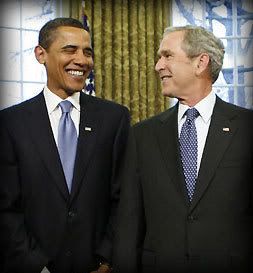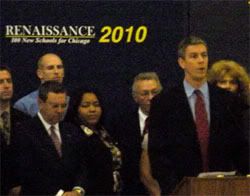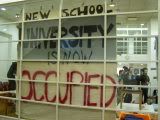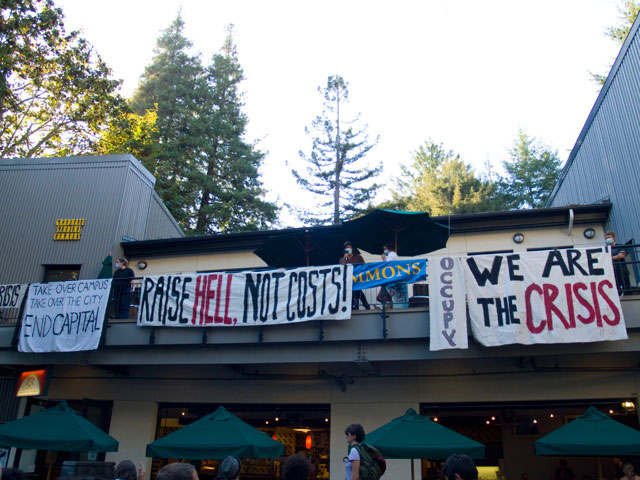One Year Later: Hope, Collapse, and Resistance
 One year ago Tuesday, Senator Barack Obama was elected as the United States' 44th President. For those of us with our ears to the ground on education issues - both primary/secondary and higher ed - we hoped for a change, especially because so much of Obama's primary and general election victory was won on the backs of countless students and youth volunteers.
One year ago Tuesday, Senator Barack Obama was elected as the United States' 44th President. For those of us with our ears to the ground on education issues - both primary/secondary and higher ed - we hoped for a change, especially because so much of Obama's primary and general election victory was won on the backs of countless students and youth volunteers.
The No Child Left Behind Act, which passed almost unanimously in the House and Senate, is widely regarded as a failure, and has done much to degrade the learning environment for students everywhere. Obama said much to that effect during the campaign, and one of his chief education advisors on his transition team was Dr. Linda Darling-Hammond, a Stanford education professor and an advocate for actually progressive education reform.
Arne Duncan: Business as Usual
But in the same way he appointed Wall Street suits to regulate their banking friends, Obama picked a corporate education suit to reform schools that were suffering from too much corporatization. When Arne Duncan was tapped for the post of Education Secretary, he was the CEO of Chicago Public Schools - a school district that had, under his close supervision, took the keys to the schoolyard away from teachers and parents and handed them to large corporate-funded non-profits, for-profit firms, and the U.S. military. He took his cues enthusiastically from Chicago's business elite, through their hand-crafted Renaissance 2010 project.
 Duncan's rhetoric is taken wholesale from his Republican predecessors - the emphasis on "accountability", standardized tests, "raising the bar", "competing globally," and general paeans to the magic of the free market. He's even stated that schools should be run more like businesses. This point isn't lost on many - even EdWeek came right out and said that Obama's education policy is "giving George W. Bush a third term."
Duncan's rhetoric is taken wholesale from his Republican predecessors - the emphasis on "accountability", standardized tests, "raising the bar", "competing globally," and general paeans to the magic of the free market. He's even stated that schools should be run more like businesses. This point isn't lost on many - even EdWeek came right out and said that Obama's education policy is "giving George W. Bush a third term."
Since his arrival, Duncan has pushed for the very changes that hobbled education in his old job. He's argued against democracy and for all powers to be vested within a single executive (like his CEO position) in large urban school districts.
"Race to the Top" — If by "Top" You Mean "Bottom"
Obama's signature education initiative in his first year was the several billion dollar "Race to the Top" initiative. The idea is to dangle the carrot of Federal education dollars in front of schools and education officials, and have them compete with each other for them. In an economic and budgetary climate that's depriving tens of billions of dollars from states and school districts nationwide, the "Race to the Top" is essentially forcing them to adopt policies and priorities of Duncan's DoE: among them introducing and expanding charter schools (and removing any caps on charter school numbers), and establishing long-discredited "merit pay" schemes for teachers. Paul Rosenberg over at OpenLeft had a great takedown of these shenanigans, concluding that:
It's really hard to see this as anything other than a Shock Doctrine-style deal, since it's a way to force cash-starved states and schools to change education policy and practice, regardless of what they might normally and democratically choose to do. And not only that--because the funds are limited, they could make the changes, and still not get a dime for doing so.
Progressive education reform would empower individual schools, teachers, and students to actively shape and determine their lives, and would equalize the enormous funding gap between affluent suburban school districts and working class urban school districts. This latest DoE scheme is just about as close to the opposite as one can get.
Higher Ed - two steps forward, two steps back
Slashed state budgets and withering private endowments have sent a shock through higher education, with tuition increases expected to accelerate even faster than they are now. On the plus side, Obama's stimulus bill provided roughly $30 billion in tax credits and expanded Pell grants to students.
The House of Representatives passed a bill (The Student Aid and Fiscal Responsibility Act) that would cut private lenders out of the Federal student loan program, which makes a ton of sense. It would reduce overhead (and profits), and turn those savings (estimated more than $80 billion over 10 years) into more Pell grants to go around. Obama has pledged to sign it, but it still needs to pass the Senate.
During the campaign, all three major Democratic candidates - Clinton, Edwards, and Obama - vowed to vigorously enforce the Solomon Amendment, which allows the President to cut off Federal funds to schools that bar ROTC or recruiters from campus (barred usually on the basis that they violate the school's anti-LGBT discrimination policy). We haven't seen any instance of Obama enforcing it just yet, but anecdotally I've seen the threat of it make things harder for students trying to demilitarize their campuses.
Although it didn't get a lot of play from traditional media outlets, the Pentagon is ramping up its involvement in University research. The new director for the Pentagon's research agency is putting a kinder, gentler face on the military-academic complex, while the DoD's Minerva Initiative and the National Science Foundation are setting up more than a dozen new military and "national security" contracts for social science research.
Resistance
Even before Obama had been sworn in, students were already resisting the corporatization of their schools - and articulating a vision of education beyond anything Democrats or Republicans could ever offer.
 On December 11, 2008, a large contingent of New School University students in New York City occupied one of their campus buildings, demanding the resignation of their university's embattled President, Executive VP, and Treasurer, along with establishing a democratic election of their replacements, a socially responsible investment committee to oversee the school's endowment, and many other demands. While not all of their demands were met, some of them were (and later in 2009 we'd hear that NSU President Bob Kerrey is indeed planning on stepping down in 2010) - and more importantly, they laid the groundwork for future occupations, including a second New School occupation months later and an occupation at New York University.
On December 11, 2008, a large contingent of New School University students in New York City occupied one of their campus buildings, demanding the resignation of their university's embattled President, Executive VP, and Treasurer, along with establishing a democratic election of their replacements, a socially responsible investment committee to oversee the school's endowment, and many other demands. While not all of their demands were met, some of them were (and later in 2009 we'd hear that NSU President Bob Kerrey is indeed planning on stepping down in 2010) - and more importantly, they laid the groundwork for future occupations, including a second New School occupation months later and an occupation at New York University.
In April of this year, one hundred students occupied administration offices at the University of Vermont just days after more than a thousand teachers and students staged a walkout - both actions condemning budget cutbacks and layoffs, especially when senior administrators are paid so much that a mere 5% pay cut for them would cover the salaries of the 27 laid off lecturers. After more than ten hours occupying the building, police dispersed the crowd and arrested 33 students. Thanks to a committed student body and campus union presence, the fight is ongoing, with multiple actions and protests since then.
 Of course the most epic mark of resistance this year could be found in California this past fall. The UC system had announced that tuition and fees for in-state students would increase more than 30 percent over the next year, coming on the heels of a previous 9.3 percent hike announced in May. Hundreds of university employees are being laid off with most remaining employees subject to furloughs. On September 24, thousands of faculty, students and staff joined to protest the massive budget cuts to the state's university system -- and to protest the complicity of the university's administrations and the Board of Regents. That week saw actions, protests, and teach-ins on every UC campus. Students at UC Santa Cruz even occupied a university building for the better part of a week. And the actions continue: in October over six hundred California students converged for a conference on the education budget, and left it resolved to plan for a day of action next March - and that same month students at Fresno State held a massive walk-out and sit-in to make demands on their administration.
Of course the most epic mark of resistance this year could be found in California this past fall. The UC system had announced that tuition and fees for in-state students would increase more than 30 percent over the next year, coming on the heels of a previous 9.3 percent hike announced in May. Hundreds of university employees are being laid off with most remaining employees subject to furloughs. On September 24, thousands of faculty, students and staff joined to protest the massive budget cuts to the state's university system -- and to protest the complicity of the university's administrations and the Board of Regents. That week saw actions, protests, and teach-ins on every UC campus. Students at UC Santa Cruz even occupied a university building for the better part of a week. And the actions continue: in October over six hundred California students converged for a conference on the education budget, and left it resolved to plan for a day of action next March - and that same month students at Fresno State held a massive walk-out and sit-in to make demands on their administration.
K-12 students, teachers, and parents are also banding together to take back their schools - from Los Angeles, to New York, to Washington DC, and many smaller, usually quiet communities in between. Independent, student-led groups are often taking the lead, like the Baltimore Algebra Project and the Philedelphia Student Union. Nationally, Students for a Democratic Society, re-established in 2006, has seen more than a hundred chapters spring up in high schools and colleges across the country, all dedicated on the premise that students deserve a free, quality, and democratic education where students and teachers - not administrators and officials - call the shots. Most chapters have held actions or are organizing against tuition hikes, layoffs, and budget cuts, and many are mobilizing for a Nov. 10 national day of action for free and liberating education for all.
There are many, many other examples of ordinary people organizing to take on the foundations of a dysfunctional education system - and that's telling in and of itself. While politicians in state and national capitals continue down the bipartisan road to ruin, folks on the ground in their own communities are working outside the ballot box to rescue themselves and build better schools - and a better world. While it would be nice if they helped, we're going to get there with or without President Obama and Congress.